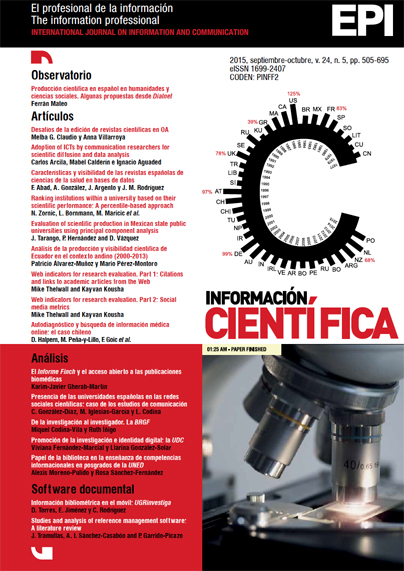Ranking institutions within a university based on their scientific performance: A percentile-based approach
DOI:
https://doi.org/10.3145/epi.2015.sep.05Keywords:
Bibliometrics, Percentile, Percentile rank classes, Scientific productivity, Scientific output, University rankings, Institutes, Schools, Faculties, I-distance.Abstract
Over the recent years, the subject of university rankings has attracted a significant amount of attention and sparked a scientific debate. However, few studies on this topic focus on elaborating the scientific performance of universities´ institutions, such as institutes, schools, and faculties. For this reason, the aim of this study is to design an appropriate framework for evaluating and ranking institutions within a university. The devised methodology ranks institutions based on the number of published papers, mean normalized citation score (MNCS), and four percentile-based indicators using the I-distance method. We applied the proposed framework and scrutinized the University of Belgrade (UB) as the biggest and the best-ranked university in Serbia. Thus, 31 faculties and 11 institutes were compared. Namely, an in-depth percentile-based analysis of the UB papers indexed in the Science Citation Index Expanded (SCIe) and the Social Science Citation Index (SSCI) for the period 2008-2011 is provided. The results clearly show considerable discrepancies in two occasions: first, when it comes to the question of leading author, and second, when it comes to analyzing the percentile rank classes (PRs) of groups of faculties.
Downloads
Downloads
Published
How to Cite
Issue
Section
License
Dissemination conditions of the articles once they are published
Authors can freely disseminate their articles on websites, social networks and repositories
However, the following conditions must be respected:
- Only the editorial version should be made public. Please do not publish preprints, postprints or proofs.
- Along with this copy, a specific mention of the publication in which the text has appeared must be included, also adding a clickable link to the URL: http://www.profesionaldelainformacion.com
- Only the final editorial version should be made public. Please do not publish preprints, postprints or proofs.
- Along with that copy, a specific mention of the publication in which the text has appeared must be included, also adding a clickable link to the URL: http://revista.profesionaldelainformacion.com
Profesional de la información journal offers the articles in open access with a Creative Commons BY license.




